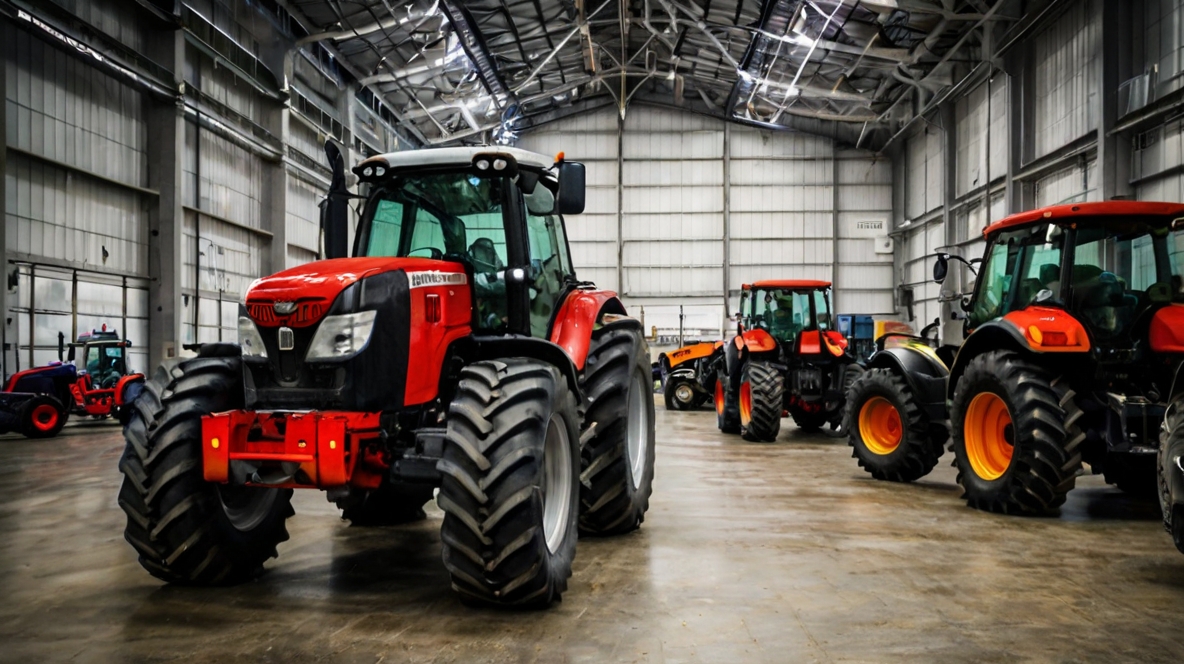
Professional equipment rental is a key pillar for many industries, from construction to events, heavy industry, and audiovisual production.
Instead of investing heavily in expensive equipment, many companies now prefer to rent. It offers more flexibility and better cost control.
For companies offering equipment rental services, this trend represents a major opportunity — but also a real operational challenge.
Rental businesses must meet varied, sometimes unpredictable demands, while ensuring availability and high-quality equipment at all times.
Managing a fleet of machines or tools requires strong logistics, precise inventory tracking, and the ability to anticipate client needs.
In a highly competitive market, it’s also critical to stand out through exceptional customer service and the smart use of digital tools.
As technology and client expectations evolve rapidly, rental companies must constantly adapt to stay ahead in the market.
This is where professional rental management solutions come into play.
These tools help streamline processes, improve inventory management, and respond faster to customer requests.
By adopting modern rental solutions, companies can boost profitability and strengthen their position in the equipment rental industry.
1. Understand the Specific Needs of Your Target Clients
1.1 Identify Industries That Require Specialized Equipment
To optimize your professional equipment rental service, you must deeply understand the industries you are serving.
Each sector has specific needs regarding equipment. Meeting those needs precisely is how you will stand out.
The construction sector is one of the biggest consumers of equipment rental services.
Construction companies require a wide range of machines, from cranes to compactors, cement mixers, and scaffolding.
Similarly, the heavy industry sector demands specialized, costly equipment like industrial compressors, generators, or heavy-duty handling machinery.
For these companies, renting equipment offers flexibility and adaptability for projects of varying sizes and durations.
Meanwhile, the events sector also relies heavily on professional equipment rental.
Organizers need sound systems, lighting, modular stages, and temporary structures tailored to each event’s specific needs.
Flexibility here is crucial, as requirements vary greatly depending on the event.
Finally, residential and commercial construction projects also demand specialized tools.
Professionals in these fields need reliable, modern equipment for tasks like drilling, cutting, welding, or lifting.
Offering modern, well-maintained tools is a key success factor for any equipment rental business.
1.2 Analyze Seasonal and Project-Specific Needs
Beyond identifying key sectors, understanding seasonal and project-specific demands is just as critical.
Construction activity peaks during milder months when weather conditions are favorable.
During these periods, demand for excavators, bulldozers, and other heavy machinery increases significantly.
For renovation projects, which can start anytime, the equipment needed varies based on the project’s nature.
Whether residential or commercial, renovation work often requires specialized tools like saws, sanders, or lifting equipment.
Private individuals also seek rental options to avoid costly investments in heavy tools for one-off projects.
By analyzing trends and anticipating seasonal or project-driven needs, you can better manage your inventory.
This ensures clients always find the equipment they need, maximizing equipment usage and meeting fluctuating demand.
With Rental, we have been helping businesses optimize their equipment rental operations for over 10 years.
Our dedicated platform is designed to simplify inventory management, streamline reservations, and boost rental profitability.
2. Optimize Your Service Offering for Greater Competitiveness
2.1 Diversify Your Equipment Rental Catalog
To stay competitive in the equipment rental market, you must offer a wide and diverse range of equipment options.
This means providing everything from small portable tools to large heavy-duty construction machines.
The professional equipment rental segment demands versatility to meet various project needs.
Adding multi-purpose tools like mini excavators, loaders, or concrete saws will attract medium-sized construction projects.
At the same time, heavy machinery like bulldozers, cranes, and large excavation equipment are crucial for major infrastructure works.
Offering specialized rental equipment such as scaffolding, aerial platforms, and soil compactors also expands your customer base.
A diversified catalog ensures you can serve small businesses, large corporations, and independent contractors alike.
The more needs you cover, the stronger your rental business will become.
2.2 Offer Additional Services to Build Client Loyalty
Today, simply offering equipment is no longer enough to stand out.
You must provide added value through complementary services that create loyalty and long-term partnerships.
Technical support is one of the most appreciated services by clients renting complex equipment.
Quick, efficient assistance during setup or troubleshooting helps prevent costly project delays and builds trust.
Delivery services are another major advantage.
Offering equipment rental with direct delivery to job sites simplifies logistics for your clients.
This is particularly valuable for heavy or bulky equipment that is difficult to transport.
Training services are increasingly requested as well, especially for advanced or specialized machinery.
Providing professional training sessions helps clients use equipment correctly and safely, while reducing damage risks.
These extra services transform a simple rental transaction into a full-service professional experience.
2.3 Offer Special Deals and Attractive Pricing
Pricing remains a decisive factor in the client’s choice of equipment rental providers.
Structuring competitive yet profitable pricing strategies is key to attracting and retaining clients.
Offering special deals during high-demand periods can boost your equipment rental revenue.
Examples include discounts for long-term rentals or bundled offers for multiple pieces of equipment rented together.
Providing attractive rates for small businesses and freelancers can help you reach more budget-conscious clients.
Volume-based or time-based discounts also encourage longer rental periods and larger orders.
With smart pricing strategies, you can increase client loyalty while maximizing your profitability.
3. Digital Marketing Strategies to Promote Your Equipment Rental Service
3.1 Build an SEO-Optimized Website
Today, having a strong online presence is essential to attract customers to your equipment rental service.
An SEO-optimized website helps you rank higher on search engines and brings you qualified traffic.
Start by strategically integrating keywords like “professional equipment rental service” and “construction equipment rental” across your pages.
Create specific landing pages for different services, like “short-term equipment rental” or “event equipment rental.”
Publish informative content such as guides on “how to choose the right construction equipment rental company.”
Helpful articles boost your credibility while improving your site’s search engine ranking.
Also, ensure your website loads quickly, is mobile-friendly, and has a clean, easy-to-navigate structure.
All these elements directly impact your SEO performance and client conversion rates.
3.2 Manage Customer Reviews and Testimonials
Customer reviews are crucial for both your reputation and your SEO rankings.
Search engines like Google consider positive reviews as strong trust signals for local SEO.
Encourage customers to leave reviews after each rental, especially for specialized equipment like scaffolding or industrial generators.
Genuine testimonials help reassure future clients and demonstrate the quality of your service.
Actively managing reviews — responding quickly and professionally to feedback — strengthens your brand’s credibility.
Showcasing customer testimonials on your website, especially on service-specific pages, can significantly boost conversion rates.
Highlighting positive experiences related to equipment rentals, like “heavy-duty machinery rental” or “audio equipment rental,” reinforces trust.
3.3 Leverage Social Media to Attract Local Customers
Social media platforms are powerful tools for promoting your equipment rental service locally.
Focus on the channels most relevant to your audience, such as LinkedIn for professionals or Facebook for broader outreach.
Share regular updates about new equipment arrivals, promotions, or success stories from your customers’ projects.
If you offer event equipment rentals, post photos or videos of live events where your gear is in use.
Visual content showcasing construction equipment, sound systems, or lighting rentals builds trust and attracts new clients.
Exclusive promotions for your social media followers can drive engagement and increase bookings.
Finally, engage actively by replying to comments, joining industry discussions, and maintaining a consistent presence.
Building a strong local community helps grow your reputation and customer base over time.
4. Efficient Management of Logistics and Inventory
4.1 Importance of Regular Equipment Maintenance
Maintaining your rental equipment regularly is critical for ensuring both reliability and customer satisfaction.
Well-maintained machines work better, last longer, and reduce the risk of costly breakdowns during rental periods.
For example, renting out industrial compressors or generators requires a strict maintenance schedule to guarantee optimal performance.
Without preventive maintenance, these machines can quickly become inefficient or fail completely.
Heavy construction equipment like cranes also needs special attention.
Regular inspections of hydraulics, cables, and mechanical systems are essential to maintain safety and functionality.
Preventive maintenance helps you spot potential issues early, avoiding expensive repairs and customer dissatisfaction.
In short, a strong maintenance program protects your investment and improves your overall rental service quality.
4.2 Optimize Inventory and Stock Management
Efficient inventory management is crucial to maximizing the profitability of your equipment rental service.
You must ensure the right equipment is available when customers need it, without overstocking unused machines.
Start by tracking rental trends carefully.
Construction equipment rental, for instance, often peaks during warmer seasons or specific project timelines.
Understanding these patterns allows you to adjust your inventory and meet demand without delays.
Use inventory management software to monitor equipment availability, track usage, and schedule maintenance automatically.
Accurate real-time data ensures your tools and machines are always ready for new projects.
Managing your inventory smartly improves turnover rates, minimizes downtime, and enhances customer satisfaction.
An optimized inventory also helps you avoid unnecessary costs and maximizes the profitability of each asset.
5. Measuring and Continuously Improving Your Rental Performance
To stay competitive in the equipment rental industry, you must measure and continuously improve your operations.
Tracking key performance indicators (KPIs) helps you adjust your services and maximize profitability.
5.1 Monitor Equipment Utilization Rates
One of the most important KPIs is equipment utilization rate.
This measures how often your machines are rented compared to their total availability.
A high utilization rate shows strong demand for your rental fleet.
A low utilization rate may reveal overstocking, underperforming products, or poor inventory planning.
For example, analyzing the utilization of your short-term construction equipment rentals can highlight where to adjust your stock.
Tracking this data lets you make better investment decisions and optimize your rental catalog.
5.2 Track Revenue Per Machine
Revenue per machine is another critical KPI for your rental business.
This metric identifies which machines generate the most income and which ones underperform.
High-performing machines should be prioritized for maintenance, marketing, and future purchases.
If some equipment brings in little revenue, consider updating, repositioning, or even replacing it.
Tracking revenue helps you focus resources on your most profitable rental assets.
It also ensures smarter planning for future equipment purchases and upgrades.
5.3 Measure Customer Satisfaction
Customer satisfaction directly impacts both loyalty and business growth.
Collect regular feedback after each rental transaction, whether for heavy machinery or specialized event equipment.
Surveys and reviews reveal strengths to build on and weaknesses to correct.
Satisfied customers return for more rentals and recommend your service to others.
Responding to feedback also shows that you care about continuous improvement.
Keeping a high customer satisfaction score ensures your rental service remains competitive over time.





